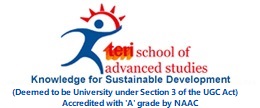
ANNOUNCEMENTS

| Date | News Title | Source |
| 18-July-2025 | 1 in 4 Indian married couples ... | The Indian Express |
| 23-June-2025 | Blended Learning: Driving educ... | The Pioneer |
| 22-June-2025 | All adults overweight in every... | |
| 21-June-2025 | TERI SAS Nurturing Global Sust... | The Interview World (Online) |
| 27-May-2025 | Eco-education trend grows: Sus... | India Today (Online- Education Desk) |
| 25-March-2025 | How water green credits can fu... | Hindustan Times (Opinion) |
| 23-February-2025 | Sustainable biz practices disc... | The Times of India (Online) |
| 21-February-2025 | Sangam fit for bath’, Enviro... | News9 (Online) |
| 12-February-2025 | A role for India in South-Sout... | The Hindu (Online) |
| 02-December-2024 | ICAR Findings Show 34% Decline... | ETV Bharat (Online) |
There is a need for a wider research and debate to arrive at the energy specific subsidies, which may be offered to to the socially unprivileged.
New Delhi: There have been recent discussions focusing on energy related support measures, both at the international level as well as within India. Availability of energy, and its affordability, has got severely impacted due to an unexpected military conflict in Europe. This has also halted global energy transition, which was moving at a smooth pace under the net-zero commitments, amidst large-scale adoption of renewables. And, within our own country, a debate has got spurred on energy related support measures for the lesser affluent sections of the society.
As part of our research work, we estimated the consumption of energy, encompassing both electric and non-electric formats, along with the related costs, to arrive at the percentage energy expenditure of an individual as part of her annual income. We undertook this study for the six states of India - Gujarat, Tamil Nadu, Karnataka, Maharashtra, Madhya Pradesh and Punjab.
Our analysis showed that annual per capita consumption of energy was in the range of 300 kgoe, equally split between electrical and non-electrical formats (refer figure 1). Within the fossil group, diesel was having a high share, indicating its widespread use as a commercial fuel. In terms of energy related expenses, our study depicted a range from INR 15,000 - 20,000, with a slightly higher share attributed to non-electric energy (refer figure 2). In terms of energy expenses as a share of annual per capita earnings, this research indicated a range of 12-15%, similar to global average values (refer figure 3).
Per capita income and per capita electricity consumption for these states was obtained from the RBI datasets. State-wise consumption of non-electric fuels (LPG, diesel and gasoline), as taken from PPAC report, was divided by the states’ population to arrive at the per capita energy consumption. Energy consumption in all forms was converted into oil equivalent terms, using standard calorific values. Tariff for electricity was computed by dividing the revenue generated with the sale of power, for domestic category of consumers (PFC dataset). For non-electric fuels, prices as prevalent during March 2019 were taken taken from the portal petroldieselprice.com.
Evolving technologies, innovative business models and opening up of energy markets, accentuated by decarbonization and electrification of the economy, had made it a challenge for the stakeholders in terms of choosing the most optimum format, among all possible permutations. Policy makers may need to choose from the various forms of energy which are required to be subsidized and the possible alternatives.
End-consumers may seek clarity in terms of fuel availability at stable price-points, with minimal change(s) in regulations. For example, subsidized tariff for consumers, amidst increasing prices of LPG and gasoline, may nudge households to adopt induction cookstoves and EVs. Similarly, rationalizing power tariffs and the proposed carbon taxation, under the Energy Conservation Act, may accelerate deployment of solar rooftop systems. Any increase in price of CNG may encourage Bio-CNG based flexi- fuel vehicles. Options shall increase the elasticity of energy consumption, typically considered inelastic.
This calls for a wider research and debate to arrive at the energy specific subsidies, which may be offered to the socially unprivileged. As a first step, minimum lifeline energy requirements can be estimated for different states, considering the existing level of expenses, climatic conditions, besides their social and demographic parameters. Other factors can include locally available fuel esources, conversion technology and the associated energy output (kgoe), market price, carbon intensity along with alternatives.
Subsidies can be extended in terms of total calorific value in place of monetary terms, possibly pegged to their carbon intensity.
This strategy shall enable a consumer opting for the most economical form of energy, which is technologically sound besides being environmentally benign, leading to sustainable and inclusive development of the Indian economy.
[This piece was written exclusively for ETEnergyworld by Dr Sapan Thapar, Head, Department of Sustainable Engineering, TERI School of Advanced Studies].
Plot No. 10, Institutional Area, Vasant Kunj, New Delhi - 110 070, India.
Tel. +91 11 71800222 (25 lines).
Website : www.terisas.ac.in
Email id : registrar@terisas.ac.in
© Copyright © 2025, TERI SAS, All rights reserved.
Visitors No.: 46398365 Since 2023


